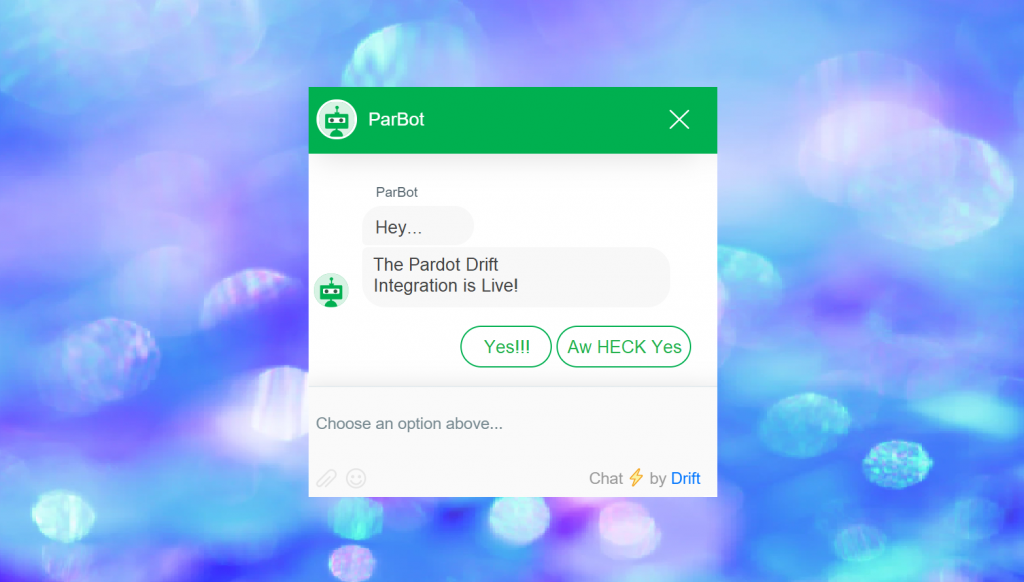If you’re a current Drift user or have been eyeing the platform, good news — Drift has an integration with Pardot.
Let’s break down the key elements of the integration.
But first — why drift integrating directly with Pardot is huge
If you’re thinking:
“Wait I already know people using Drift and Pardot together. What’s the big deal?”
You’re not wrong — but this step adds even more power to the dynamic duo.
Drift has many current Pardot customers leveraging conversational marketing to capture leads and create a more engaging, targeted experience for their website visitors.
But in the past, most Pardot customers integrated Drift directly with Salesforce, using it to create/update new leads and contacts — meaning if marketing wanted to spend more time pre-qualifying Chatty Cathy before she hits Salesforce, they were out of luck.

Selectively sync between systems using the Drift / Pardot integration
The newly minted Drift integration gives marketing more granular control over when data is passed between systems — both from Drift to Pardot, and Pardot to Salesforce.
The integration is capable of syncing all leads to Pardot automatically or syncing new leads based on the Conversation Qualified Lead (CQL) score that a conversation is assigned within Drift:

This is huge — because it lets you set a bar to ensure that only quality conversations migrate into Pardot for further nurturing. And because the first stop is Pardot, you can put that lead through any of your regular lead scoring and qualification activities before routing to sales.
Connect custom fields to continue the prospect conversation in Pardot
The integration can map custom fields between Drift and Pardot — opening the door to using the data you’re capturing in Drift in segmentation, personalization, and reporting:

For example, you could create a Drift field for product interest and map that to Pardot, and then use that to drive people to an Engagement Studio nurture or route to reps in that business unit.
The basic concept is that Drift starts the conversation, and Pardot continues it after people have left the website… and Drift arms Pardot with data to target prospects based on where they’re at in the journey. Then using Pardot, marketers can send email campaign to encourage re-engagement and get people back to the website — where Drift picks up again.
An Example: Leveraging the Drift/Pardot integration to improve customer experience
To run effective campaigns, it is hugely important to bridge data gaps between systems and have one clear picture of the entire customer and their buying lifecycle. The average enterprise leverages a whopping 91 cloud services for marketing alone — and if key info is sitting in silos, it’s pretty easy to end up with a black eye.
A major silo we often see is customer service service data. The marketing department needs this info too to inform effective engagement.
Think about it — do you really want to be hard selling an account that has a stack of escalated cases? Not a good look. If a customer is using Service Cloud, we can easily create a suppression list based on open cases (using a custom object in Pardot) to hold back promotional mailing until a case is resolved.
Chatbots are another place customers may turn for an “airing of grievances” — and the Drift / Pardot integration busts one more data silo, allowing you to drive a better customer experience based on what was discussed in a Drift chat.
For example, maybe the conversation was support related. By noting that in Drift, you could suppress marketing messages to allow time for the support conversation to work itself out.
Or maybe the conversation was regarding features or capabilities, and noting this in Drift could be used to trigger a topical Engagement Studio Program focused on training and customer adoption. So many possibilities here!
What’s your take on the Drift Pardot integration?
If you’re saying “sign me up,” check out Drift’s help documentation on how to get started.
What questions do you have? Are there other items on your integration wishlist? We also have the integration up and running in Sercante’s training environment — ping us for a demo.











